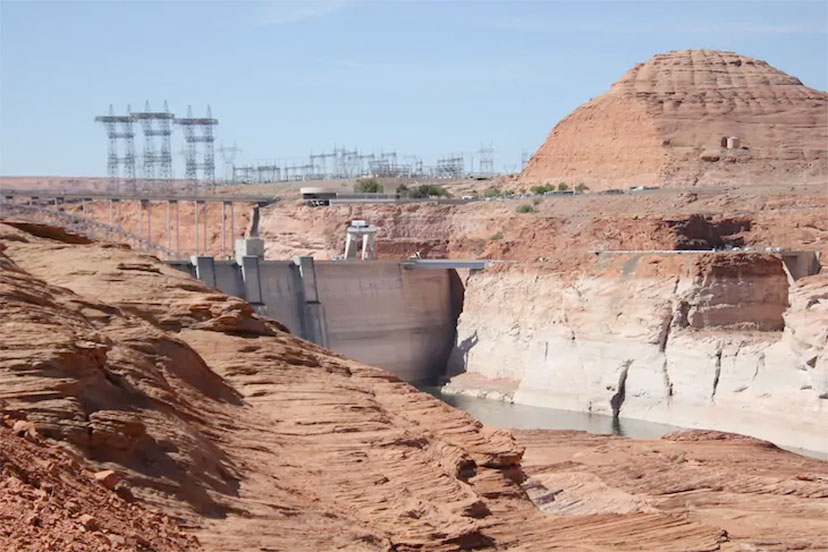PHOTO: Water levels in Lake Powell have been rising rapidly this year, but in May 2022 there was a very real risk that levels would drop too low for hydroelectric generation. Photo by Allen Best.
This op-ed appeared on Big Pivots on June 8, 2023. We are sharing it in two parts.
Almost everybody has heard talk about whether the 1922 Colorado River Compact needs to be renegotiated, said Becky Mitchell, Executive Director of the Colorado Water Conservation Board, at the Colorado Drought Summit on May 31.
It does not, she declared. Instead, it needs to be honored.
A bit of history:
The two largest reservoirs in the American West — Lake Mead and Lake Powell — entered the 20th century close to full. The 1990s had been good snow years and the upper basin states had not developed their full allocation of 7.5 million acre-feet. California famously had been allocated 4.4 but was using about 5.5
Then came the lean years, worst of all 2002. The river carried only 4.5 million acre-feet of water. Attorneys who framed the Colorado River Compact had assumed 20 million acre-feet of water on average. The thin “bathtub rings” on the sides of the reservoirs representing high marks widened considerably—and then widened more in subsequent years.
The first response was the Interim Guidelines of 2007. Then came other very small belt-tightening measures. California, for example, cut back to its legal entitlement.
By 2015, though, it had become clear that more would be needed. A modestly good water year allowed the lower-basin states to postpone any serious talk. Then came a bad year—and finally there was action. The result was the 2019 drought contingency plan.
At the time, Brad Udall, who has family roots in Arizona but a lifetime mostly in Colorado, told me that he believed that 2019 agreement that was broadly heralded was not close to being enough. “I hope I’m wrong,” he said.
He wasn’t.
More lean years followed, the reservoirs shrank, and the small measures weren’t near enough.
In their remarks at the Colorado Drought Summit in Denver on June 1, Becky Mitchell and Chuck Cullom, Director of the Upper Colorado River Commission, mentioned several of those efforts in the upper basin, with Mitchell describing one as “clumsy.” Cullom said something similar, noting the call for accelerated action as not without risk. “Part of the challenge with picking up the pace is you stub your toe,” he said, alluding to mistakes made in the system conservation pilot program.
Finally, in August 2021, the Colorado River story became national in a way that it had not been before.
“In a First, U.S. Declares Shortage on Colorado River, Forcing Water Cuts,” announced the New York Times.
That cut off some farmers in Arizona. More reduction was needed, though.
On June 14, 2022, Camille Calimlim Touton, the commissioner of the Bureau of Reclamation, which is sort of the task-master on the Colorado River because of its role in regulating the dams, told the Senate Committee on Energy and Natural Resources that between 2 and 4 million acre-feet of additional conservation was needed just to protect reservoir levels. She gave the basin states 60 days to come up with a plan.
To compare, the entire state of Colorado uses about 2.2 million acre-feet from the river each year.
“I wasn’t surprised by the two-million acre-feet,” recounted Mitchell at the conference. “It wasn’t rocket science. It was addition and subtraction. It’s not even multiplication and division. It didn’t work. There was an overuse that was not sustainable.”
That deadline from the Bureau of Reclamation was missed, as was an extension.
Finally, in late January, something came out, but it also fell short. California wasn’t on board.
“Cut the crap,” Udall was quoted as saying in a Denver Post story in January.
Finally in late May, a new agreement was announced, getting front page attention from New York and Washington DC to Los Angeles (and, of course, in Denver).
“We’ve received a page and a half of bullet points saying what the lower-basin intends to do. We don’t know how they’ll do it. We don’t know where the water will come from (among existing uses). We don’t know if it will be binding and enforceable,” said Mitchell.
She said Colorado and other upper basin states are waiting to see a revised draft supplement environmental impact statement.
Mitchell was unsparing. “I think it’s also important to recognize that we don’t get paid for the conservation that happens in the upper-basin states, because it’s in response to hydrology,” she said.
There is yet another bone of contention, one that all but Colorado River wonks will have a hard time understanding. That is, who takes responsibility for evaporation from the reservoirs, as well as transmission loss.
Hydrologists estimate a million acre-feet of evaporation occurs on Lake Mead – but in the accounting of the lower-basin states, he said, it doesn’t exist.
“In the lower basin,” said Cullom, “they, uh, somehow , uh, there’s an atmospheric thing that prevents evaporation from being considered. Apparently physics doesn’t work (the same) everywhere.”
Allen Best publishes the e-journal Big Pivots, which chronicles the energy transition in Colorado and beyond.

